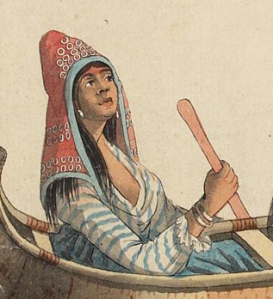The Junto is on fire this week! First, they published Casey Schmitt’s review of Sowande’ Mustakeem’s Slavery at Sea, and then followed it up with Rachel Herrmann’s in-depth interview with Mustakeem about the writing of the book. Here, Mustakeem reminds us of the importance of thinking critically about the entire population of captured Africans who became our ancestors in the U.S.–it wasn’t just healthy, able-bodied young men, but it included older people, sick people, and of course, girls and women as well as men.
Today, Sara Damiano has published a wonderful guide to assigning and using more primary sources by women in the first “half” of the U.S. History survey. (I say “half,” because when one starts a class in 1492 and ends in 1877 that’s 385 years; so if the following course begins in 1877 and goes roughly through 2001, that’s only 124 years. I’m not sayin’–I’m just sayin’.)

Wabanaki woman in red woolen hood with blue ribbon trim and trade silver. Image from Library & Archives Canada
Damiano says that in making a concerted effort to include primary sources by women throughout the course, rather than limiting their appearance to a sprinkle here and there, meant that she could engage questions about gender across time and space, and that it forced her to rethink the whole purpose of assigning students primary sources in survey classes. Check it out. She’s got a nice checklist that outlines her method.
Be sure to take full advantage of every source you see:
Finally, did you know that there is a new blog called the Stars Hollow Historical Society? This seems totally brilliant, and well-timed to correspond to the Gilmore Girls reboot that debuted over the holidays. They’re accepting pitches and submissions from anyone who wants to write about “public history and heritage tourism” in the Gilmore Girls. (I love the concept of the blog but the bright salmon-pink background is just too much. It hurts to read, whereas anything involving the Gilmore Girls, public history, and representations of heritage tourism in Stars Hollow should be nothing but a pleasure! I love the pink, but tone the shade down a bit to enhance the contrast?)
More girls, just for fun. There are some things you can’t cover up with lipstick and powder/Thought I heard you mention my name, can’t you talk any louder?
Take it away, girls and boys–

Great stuff at the Junto!
(Your link to stars hollow has an extra “.c/” to it. Feel free to delete this.)
LikeLike
Thanks–fixed the link!
LikeLike
I have trouble even with the term “U.S. History Survey,” because that name should be nominated for a big fat Whiggy, in presuming that those lithic folks tromped across a “land,” or “ice” “bridge” to get good seats in the pit for the “opening” groups in the rock opera about the creation of a recent nation state-of-states. As opposed to, say, recreational tourists, looking to bag some trophy megafauna. State regulators and educrats win out, though. We have to call it that, because teaching certificate programs require it. Accreditors demand it. But it sets the stage for my first act of subversion, dismantling the top line on the syllabus, the very name of the course itself. How can calling anything “American” be an act of subversion in Trumpsylvania? Sad. On the chronology and periodization thing, I start the proceedings about X’ty-two thousand years ago and run the ball up to 1800, then turn and lateral that baby to our recent Ameri…. uh, oh!! who isn’t there!!! Never. So we always start the second “half,” every semester, with a turnover. Sadder. Sue me. Release me.
LikeLike
I hear you. I always try to deconstruct this Frankenclass, which reads an Anglocentric view of North American colonization into the past and glues it (badly, I’m sure) to U.S. history, which properly begins only in 1776, or maybe 1765 if I’m feeling generous. Bah!
LikeLike
Hi nicee reading your blog
LikeLike